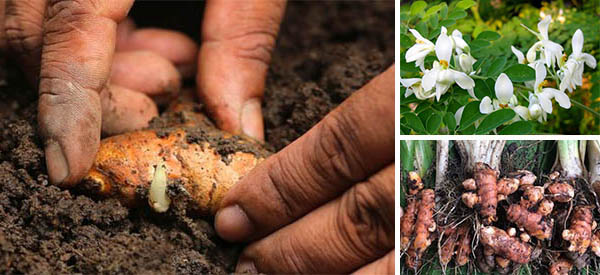
7 Medicinal Herbs You Can Grow In House
Growing your own medicinal herbs does not require copious amounts of space. In fact, many of the most frequently grown natural remedies can be grown indoors year-round no matter where you live. Here are 7 Medicinal Herbs You Can Grow In House!
Cultivating your own medicinal herbs enhances your survival medical preps exponentially. Creating an apothecary patch outside is ideal, but only having a seasonal herb growing operation shortchanges plans to grow your own pharmacy.
When growing medicinal herbs indoors, you have the ability to add dwarf and non-native varieties of healing herbs, roots, and plants into your survival apothecary growing plan. One of the most potent healing herbs on the planet can only be grown in a few select hot regions of America – the Moringa tree.
On our survival homestead in Appalachia we regularly enjoy the benefits of the Moringa tree. No, it is surely not a hot enough climate to cultivate the tall drumstick style trees outside year-round, but by growing a dwarf version of the Moringa tree we have access to its healing powers any time we need.
1.Turmeric
This is always a “go to” survival herb. Turmeric is the only source of the extremely powerful antioxidant, curcumin. To harvest active compounds from turmeric you only need to harvest the root cuttings, or dried rhizomes of the plant.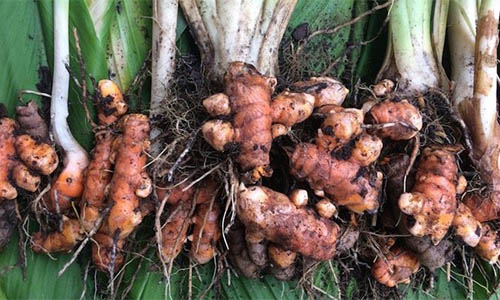 The curcumin in turmeric has been used for centuries in natural healing. Herbalists favor this orange root for treating common conditions such as arthritis, muscle and joint inflammation, and to make “Golden Milk”, to treat the cold and flu.
The curcumin in turmeric has been used for centuries in natural healing. Herbalists favor this orange root for treating common conditions such as arthritis, muscle and joint inflammation, and to make “Golden Milk”, to treat the cold and flu.
Turmeric has also been used to help fight depression, Alzheimer’s Disease, and even in homeopathic cancer regimens. Due to curcumin’s possible ability to improve the lining of blood vessels, it may also be helpful in fighting heart disease.
Turmeric Growing Tips
One turmeric root purchased from a garden center is usually enough to start multiple cuttings from. Turmeric roots should be planted in a slightly moistened potting soil.
First, break up or carefully snip the turmeric root into small parts, ensuring that each one contains a bud. If you have ever planted seed potatoes before, this initial process of preparing to plant turmeric root is nearly identical.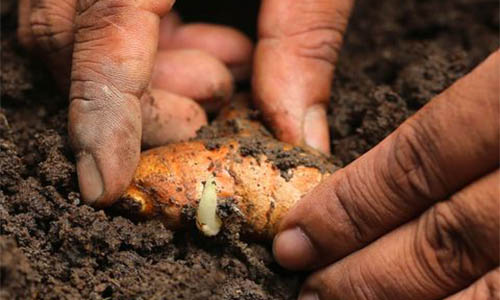 Place one turmeric root piece into a 5-gallon bucket or similarly sized growing container. Make sure that the container used has drainage holes poked or drilled through the bottom. When growing turmeric pot size matters – the larger the pot, the better and bigger the roots will grow.
Place one turmeric root piece into a 5-gallon bucket or similarly sized growing container. Make sure that the container used has drainage holes poked or drilled through the bottom. When growing turmeric pot size matters – the larger the pot, the better and bigger the roots will grow.
Plant the turmeric roots with the bud facing up and two inches deep in the potting soil.
While turmeric rhizomes can grow quite well under grow lights, they will thrive in a natural light full sun environment. Once the threat of frost has passed, it is highly recommended to move the 5-gallon pots outside during the late weeks or spring and summer months.
Water the turmeric about once every two days to make sure the soil remains moist. You can mist the growing turmeric just lightly in between the waterings to help keep the soil moist, but never mist or water so much that the soil becomes soggy or rot will occur.
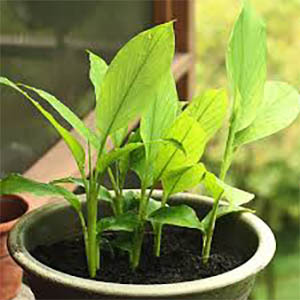 It takes roughly eight to ten months for the turmeric roots to mature. You can save some rhizome parts for the harvest to use in replanting – but never replant in the same soil because of nutrient depletion.
It takes roughly eight to ten months for the turmeric roots to mature. You can save some rhizome parts for the harvest to use in replanting – but never replant in the same soil because of nutrient depletion.
Once the turmeric has matured and has been harvested, boil the roots for approximately 45 minutes. Next, put them on a drying rack in a cool and dry spot for about one week.
After the turmeric roots are dried, put on gloves to prevent the orange powdery surface of the rhizomes from staining anything they touch. Peel the rhizomes and they are ready for use.
2.Dwarf Moringa Trees
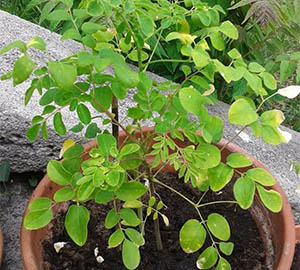 Every single part of the Moringa Tree (or the “Tree of Life”, as it has often been dubbed) is edible. These quick growing trees can be grown outdoors only if the prepper cultivating them lives in Texas, Florida, Arizona, or California.
Every single part of the Moringa Tree (or the “Tree of Life”, as it has often been dubbed) is edible. These quick growing trees can be grown outdoors only if the prepper cultivating them lives in Texas, Florida, Arizona, or California.
However, the dwarf variety can be grown indoors in portable pots, no matter the climate.
Moringa trees boast significant amounts of vitamins A, B, C, E, and K. The tree parts are also rich in essential amino acids, manganese, protein, and beta-carotene.
Leaves from the Moringa tree can be infused into a tea, consumed raw, or dehydrated to make them more shelf stable. The bark and gum from the Tree of Life are often consumed in teas for their medicinal properties.
Moringa tree flowers are also eaten raw, but taste delicious when either boiled or fried.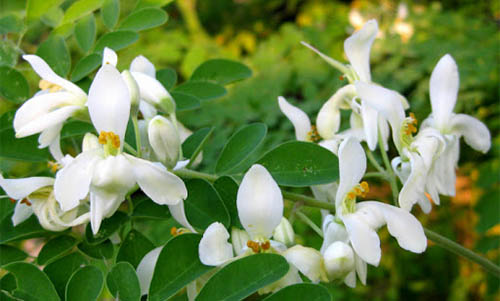 Pods from this tree can be cracked open and the inside scooped out, to be eaten much in the same way as okra.
Pods from this tree can be cracked open and the inside scooped out, to be eaten much in the same way as okra.
Ben oil is contained inside of the seeds found in the drumstick shaped portion of Moringa trees. Ben oil is often used as an active ingredient in natural home remedies. The oil may also be used as a lubricant in both machinery and firearms, and to filter water (to make it potable).
Related: How To Make Moringa Powder and Improve Your Liver (DIY – With Pictures)
Moringa Tree Growing Tips
It takes approximately two weeks for the dwarf Moringa tree seeds to sprout.
The seeds should be planted in a well-draining container about half an inch below the surface.
In a container that is 16 inches in diameter, you can plant roughly eight seeds – thinning out the sprouts later as needed.
Leaves from the Moringa tree can be eaten as they are, freshly picked, once the tree has a healthy and abundant leaf growth (as it matures).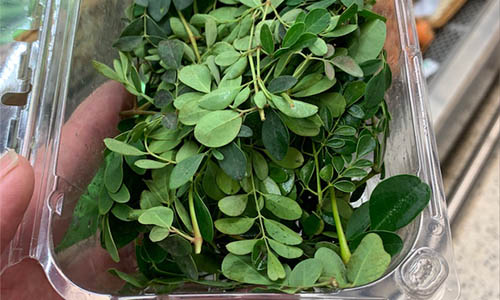 Moringa trees will not grow well when living in soggy soil. If the leaves start to turn yellow, check the moisture level of the soil and infuse more magnesium into the dirt. I typically use Epsom salts or crushed eggshells to increase the level of magnesium in soil.
Moringa trees will not grow well when living in soggy soil. If the leaves start to turn yellow, check the moisture level of the soil and infuse more magnesium into the dirt. I typically use Epsom salts or crushed eggshells to increase the level of magnesium in soil.
Related: 10 Trees Everyone Should Know and Why
3.Tarragon
This easy to grow herb is often used to naturally treat toothache pain, digestive issues, water retention, insomnia, improve appetite, and to help enhance insulin sensitivity while regulating blood sugar.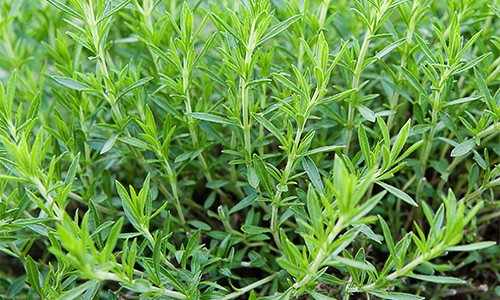
Tarragon Growing Tips
Sow the seeds approximately four to six inches deep in a medium sized container.
Covering the seeds just lightly with a cotton cloth or a paper towel until they sprout can help replicate low light conditions, that help tarragon seeds thrive.
Tarragon grows best in a moist and lightweight potting soil.
Thinning out the tarragon seeds once they are a minimum of two inches tall and transplanting them into individual pots is highly recommended.
4.Echinacea
These beautiful and hardy flowers can be brewed into a tea that can help both fight and prevent respiratory issues, like the common cold and the flu.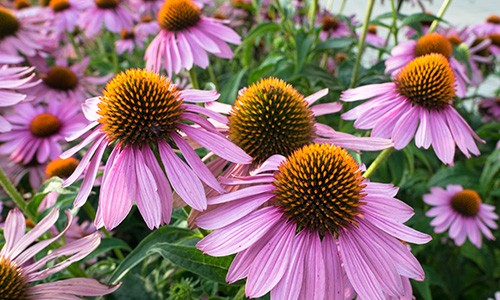 Drinking the tea up to four times a day when you start to feel a related illness coming on is how adults typically use echinacea tea. Typically, it can take up to 10 days for brewed echinacea to boost the immune system and help whip the cold or infection.
Drinking the tea up to four times a day when you start to feel a related illness coming on is how adults typically use echinacea tea. Typically, it can take up to 10 days for brewed echinacea to boost the immune system and help whip the cold or infection.
Echinacea Growing Tips
This herbal flower grows well in a full sun environment and when cultivated in a nutrient rich soil.
Echinacea grows best when exposed to only a small amount of water, but not to the extent that the soil is allowed to become dried out.
Echinacea can typically withstand a light frost if the plants are moved outdoors from spring through fall.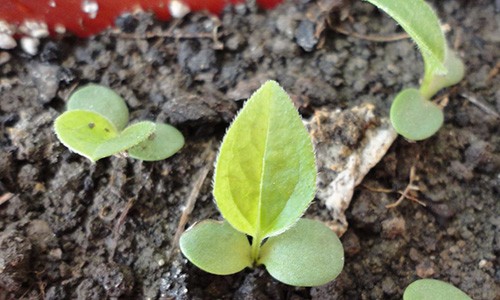 It takes roughly 90 to 120 days for echinacea to sprout from seed and flower. This healing flowering herb plant grows to about 48 inches tall.
It takes roughly 90 to 120 days for echinacea to sprout from seed and flower. This healing flowering herb plant grows to about 48 inches tall.
5.Thyme
This is perhaps one of the simplest and easiest to cultivate of all the healing herbs that can be grown indoors. Thyme is often used in natural home remedies because of its antibacterial, insecticidal and antiseptic properties.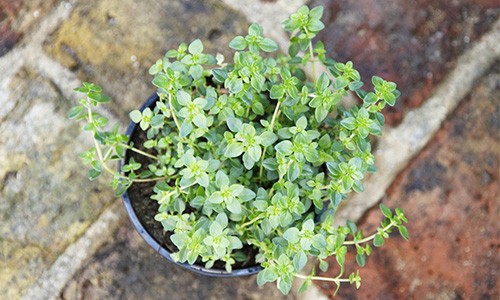 When the “Black Death” swept through Europe during the 1300s, Thyme was steeped into a tea and used to help treat symptoms of the deadly virus. The herbal tea can help boost the immune system and relieve coughing fits.
When the “Black Death” swept through Europe during the 1300s, Thyme was steeped into a tea and used to help treat symptoms of the deadly virus. The herbal tea can help boost the immune system and relieve coughing fits.
Thyme contains a natural biocide known as thymol. This compound may help kill infectious bacteria and other types of harmful bacterial organisms.
Thyme Growing Tips
Thyme grows best in a well-draining and lightweight soil and in a full sun environment.
For best results, grow thyme in a soil that has a pH balance of 6.5 to 7.0.
6.Garlic
If I could only grow one herb indoors, it would be garlic. I use garlic as an active natural base ingredient in at least 90% of the home remedies that I create, to prevent and treat colds and respiratory problems, to remove toxins from humans and animals, as well as to give a general overall boost to the immune system.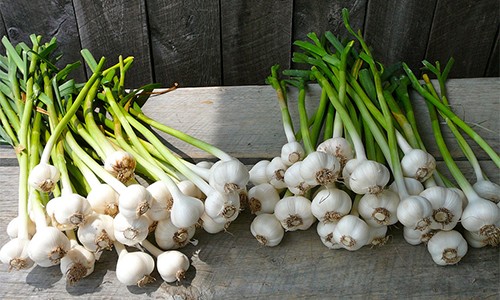
Top Garlic Medicinal Uses:
- Remove impurities and toxins from the body, both topically and internally.
- To treat common symptoms associated with the flu, common cold, and respiratory issues.
- To both prevent and treat gum disease.
- To treat yeast infections.
- To heal cold sores.
- To turn it into an oil that is used alone, or as part of a drawing salve recipe to help pull out splinters and infection in minor wounds and bug bites.
Related: How To Prepare Medicinal Pickled Garlic
Garlic Growing Tips
The narrow and most pointy part of garlic clove must be planted into the soil towards the surface facing up and not facing down .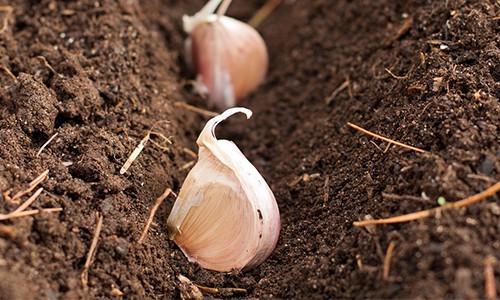 Plant the cloves root side down roughly four to six inches deep in a rich potting soil.
Plant the cloves root side down roughly four to six inches deep in a rich potting soil.
Garlic cloves can be placed in the same indoor growing container, but they must be placed about two inches apart.
7.Basil
This healing herb has been traditionally used to aid in the healing of both minor burns and wounds. The antiparasitic compounds in basil also make it a superb natural dewormer for both livestock and humans.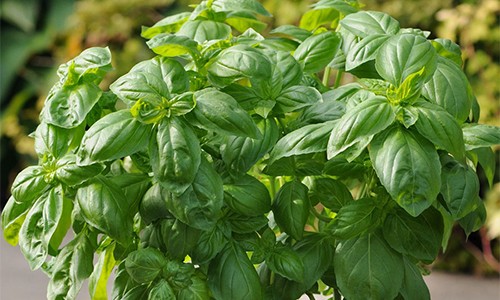 Basil has also been utilized to help spark appetite, treat kidney problems, to aid in the removal of warts, to deter fluid retention, and to ease the symptoms associated with the common cold.
Basil has also been utilized to help spark appetite, treat kidney problems, to aid in the removal of warts, to deter fluid retention, and to ease the symptoms associated with the common cold.
Nursing mothers have used basil to increase their flow of breast milk. Native American tribes once used basil in a poultice to draw out snake venom, after being bitten.
Basil Growing Tips
Basil seeds should be planted one fourth of an inch deep in a well-draining and moist soil. Basil thrives in a soil with a neutral pH balance.It is best to wait to water basil until the soil is nearly dry to the touch. Grow this medicinal herb in a full sun environment.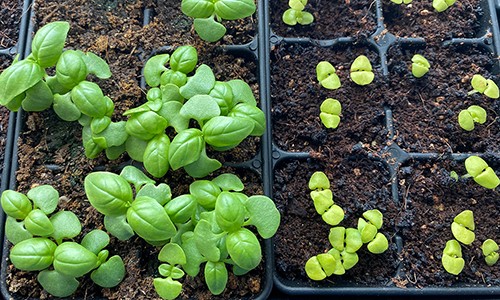
There are numerous healing herbs that can be grown successfully indoors year-round, but these are the ones I consider to be the most potent and multi-use. It does not take a green thumb to cultivate an apothecary patch indoors or outdoors. This will allow you to be better prepared to prevent and treat illness in your family at all times.
You may also like:
 Edibility Test: Find Out Which Backyard Weeds are Edible
Edibility Test: Find Out Which Backyard Weeds are Edible
The US Army’s Forgotten Food Miracle (Video)
How to Make Cabbage Bandages to Treat Inflammation and Joint Pain
21 Wild Edibles You Can Find in Urban Areas






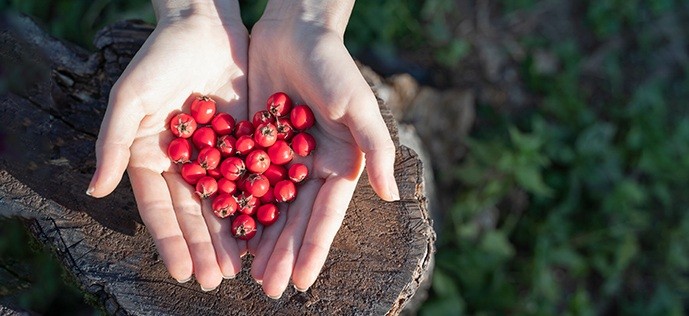
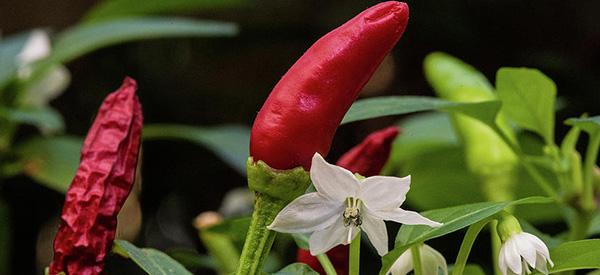
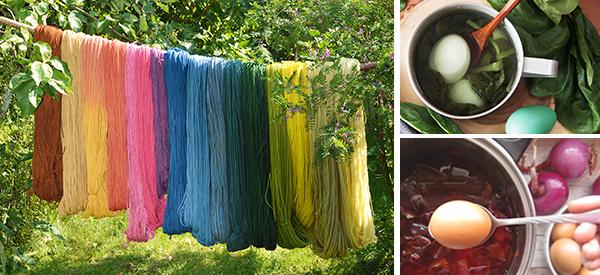
Great article!! I’m going to take notes. At my new house in planning in doing all edible and medicinal landscape. This is a great start! Where can we but moringa tree seeds?
http://www.treeseeds.com/moringatreeseeds
Hi Sara,
Thank you so much for your kind words. We really appreciate it.
You can find moringa seeds here: https://medicinalkit.com/kit-tsl
God bless!
Love the idea. Moringa grows everywhere residing here in Dutch Caribbean. Hope to find Turmeric to start planting. Thanks very much.
Hi Asyla,
Thank you so much for your comment. We really appreciate it!
God bless!
The Black Death was actually due to a type of bacteria, not a virus. (Yersinia Pestis). Nonetheless, thyme must have anti bacterial properties if it helped get rid of the Black Death!
Please let us know where we can get Moringa Tree seeds. Thank you Jim
http://www.treeseeds.com/moringatreeseeds
Can you tell me why I and others get something like fruit flies so badly when we grow basil indoors? Maybe how to control them? So disappointing because I love basil! Thank you!
Also Amazon
Please tell us where we can buy Moringa Tree seeds. Jim
Hi Jim,
Thank you so much for your comment. You can purchase Moringa Tree Seeds by accessing the link below:
http://www.treeseeds.com/moringatreeseeds
God bless!
Hi Jim,
Thank you so much for your comment.
You can purchase Moringa Tree Seeds by accessing the link below:
https://medicinalkit.com/kit-tsl
God bless!
[…] 7 Medicinal Herbs You Can Grow In House […]
[…] 7 Medicinal Herbs You Can Grow In House […]
[…] 7 Medicinal Herbs You Can Grow In House […]
Hi Nicole!
Everybody I know including myself, get bugs about the size of a fruit fly whenever we grow basil indoors. Do you know why this is and now to control it? It’s so disappointing because I Love basil.
Thank you for what you do and who you are.💜